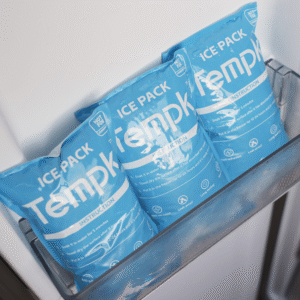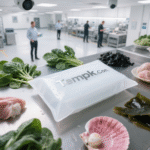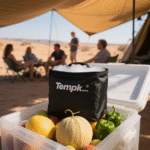How to Use Ice sèche Packs Medical Safely in 2025
If you ship with dry ice packs medical, success depends on right sizing, vented packaging, and precise labels. Expect carrier acceptance checks against 2025 IATA/DOT job aids, UN1845 with net mass in kg, and triple packaging for UN3373 where needed. USPS retains stricter dry‑ice limits for air pieces; plan accordingly.

-
Choose when dry ice packs medical beat gel/PCM for ultracold routes
-
Size dry ice for 24–96 hours with a buffer and validation plan
-
Pick EPS, PPE, or VIP shippers to cut ice mass and DIM weight
-
Label, mark, and document shipments to pass 2025 acceptance checks
-
Apply UN3373 (PI 650) rules with dry ice outside the secondary
What does “dry ice packs medical” mean in 2025?
Réponse courte: solid CO₂ used as coolant for vaccines, biologique, and diagnostics—pas a hazardous content when used only as a refrigerant—requiring UN1845, proper shipping name, net dry‑ice mass (kg) on the outer package, et vented conditionnement. These points appear on 2025 airline acceptance checklists and U.S. 49 CFR guidance.
Why it matters to you: most holds happen for missing net‑kg marks, obstructed Class 9 labels, or airtight liners. Treat label layout like a blueprint; carriers now verify it at origin using refreshed job aids.
How do you size dry ice packs medical for 24–96 hours?
Core guidance: plan ~2.3–4.5 kg per 24 h per parcel, then add a 20–30% delay buffer. Validate with a data logger on your first two runs and adjust by container type: VIP < PPE < EPS in heat‑leak.
Make it practical: heat enters through the walls and headspace. Tight fill, a rigid divider, and top‑loading dry ice slow burn. Use dry ice for frozen/ultracold lanes; prefer PCM for 2–8 °C to avoid over‑cooling. Keep the package vent path unobstructed.
Quick estimator (baseline only)
| Use case | Typical insulation | Heures | Est. glace carbonique (kg) | What it means for you |
|---|---|---|---|---|
| Clinical trial kits | PSE 30 mm | 24–36 | 3.5–5.0 | Add PCM near payload; shrink headspace |
| Vaccine shippers | PPE 40 mm | 36–48 | 4.5–6.0 | Use rigid divider; top‑load ice |
| Ultracold vials | VIP hybrid | 48–72 | 5.0–8.0 | Fewer re‑ice steps; smaller carton |
Field note: Teams that added a rigid top tray and printed UN1845/net‑kg in large, unobstructed text reported fewer acceptance delays and steadier 72‑hour holds in summer heat.
Which containers pair best with dry ice packs medical?
Choose the container first. EPS is cost‑effective for ≤48 h lanes; EPP survives reuse and rough handling; VIP cuts heat‑leak for 48–96 h lanes, reducing ice mass and dimensional weight. All designs must vent CO₂.
EPS vs. EPP vs. VIP at a glance
| Container type | Best for | Ice impact | What it means for you |
|---|---|---|---|
| PSE (25–40 mm) | 24–48 h | Higher burn | Budget starter for clinics |
| PPE (30–50 mm) | 36–72 h, reuse | Moderate burn | Durable; cleaner acceptance surfaces |
| VIP hybrid | 48–96 h, hot lanes | Lowest burn | Smaller cartons; fewer re‑ice events |
How to label and document dry ice packs medical dans 2025?
Checklist to clear acceptance:
-
Mark “Dry ice” / “Carbon dioxide, solid” et UN1845 on the outer package.
-
Ajouter net dry‑ice mass in kilograms; keep labels unobstructed.
-
Utiliser Class 9 where required; include shipper/consignee addresses.
-
Ensure vented conditionnement; never airtight.
-
Follow operator job aids at tender; overpacks must show total net kg.
Postal nuance: USPS domestic air limits dry‑ice quantity per mailpiece and requires vented packaging; plan around these weight caps when choosing parcel vs. freight.
Do dry ice packs medical change UN3373 or vaccine handling?
For UN3373 (PI 650): use triple packaging and place dry ice outside the secondary container, separated by a rigid divider; still mark UN1845 with net‑kg on the outer. No Shipper’s Declaration is needed when dry ice is used solely as a coolant and other criteria are met.
For vaccines: match coolant to label. Ultracold vials ride with dry ice and VIP/EPP shippers; 2–8 °C vaccines ride with PCM. Always pre‑condition product and log temperatures from door to door.
Practical tips & pro moves
-
Top‑load the ice; cold sinks and protects payload beneath a rigid divider.
-
Shrink headspace to slow sublimation and reduce ice mass.
-
Standardize label layout so UN1845 and net‑kg are visible and never drawn inside the Class 9 border.
CO₂ safety when using dry ice packs medical
CO₂ is an asphyxiant. Train staff on symptoms, stage parcels in ventilated areas, and avoid sealing dry ice in non‑vented containers. Facilities handling larger volumes benefit from floor‑level CO₂ sensors and simple alarm tests per shift.
2025 developments and trends in medical cold chain
What’s new: Airlines adopted focused dry‑ice acceptance checklists, carriers refreshed job aids with text‑size and overpack‑total guidance, and many labs shifted to VIP to trade ice mass for insulation. Physics still rules—CO₂ sublimation drives your sizing math—so validate, then lock SOPs.
Latest progress at a glance
-
Carrier clarity: clearer label zones and overpack totals speed origin checks.
-
UN3373 harmonization: practical PI 650 steps are easier to teach and audit.
-
Hybrid packouts: PCM near product + dry ice above reduces excursions on long lanes.
Market insight: VIP adoption grows on hot, long routes; teams report fewer re‑ice events and smaller cartons with better acceptance velocity.
FAQ
Do dry ice packs medical require a Shipper’s Declaration?
Not when used solely as coolant with non‑DG contents under the relevant packing instruction, provided markings and venting are correct. Check operator variations.
How much dry ice per day should I plan?
Start with ~2.3–4.5 kg per 24 h per parcel, add 20–30% buffer, and validate with a data logger on two pilot runs.
Where must the dry‑ice label go?
On the outer package with UN1845, proper name, net‑kg, and addresses; keep the Class 9 label unobstructed by tape or straps.
Does USPS treat dry ice differently?
Oui. Domestic air pieces face lower dry‑ice caps and must be vented; confirm piece weight before choosing a postal lane.
What’s the simplest way to avoid acceptance holds?
Pre‑print UN1845/net‑kg at readable size, keep a clean label field, and use the current acceptance checklist at tender.
À propos du tempk
We help healthcare brands, labs, and CROs design regulation‑ready packouts that cut excursions and acceptance delays. Our modeling pairs container and coolant, our label kits mirror carrier job aids, and our SOPs are built for busy docks. Clients often reduce exceptions 20–40% after deployment.
Get your personalized dry ice packs medical packout and label map today.























